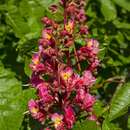en
names in breadcrumbs


Aesculus × carnea, or red horse-chestnut,[1] is a medium-sized tree, an artificial hybrid between A. pavia (red buckeye) and A. hippocastanum (horse-chestnut). Its origin uncertain, probably appearing in Germany before 1820. It is a popular tree in large gardens and parks.
Aesculus × carnea's features are typically intermediate between the parent species, but it inherits the red flower color from A. pavia. Its showy flowers are borne in plumes on branch ends, blooming in spring and producing leathery fruit capsules in fall. It grows up to 40 feet (12 m) tall and 30 feet (9 m) wide, with a round head that casts dense shade when mature. Its leaves are dark green, palmately compound, and deciduous, each leaf divided into five large, toothed leaflets.[2]
![]() Media related to Aesculus × carnea at Wikimedia Commons
Media related to Aesculus × carnea at Wikimedia Commons
Aesculus × carnea, or red horse-chestnut, is a medium-sized tree, an artificial hybrid between A. pavia (red buckeye) and A. hippocastanum (horse-chestnut). Its origin uncertain, probably appearing in Germany before 1820. It is a popular tree in large gardens and parks.
Aesculus × carnea's features are typically intermediate between the parent species, but it inherits the red flower color from A. pavia. Its showy flowers are borne in plumes on branch ends, blooming in spring and producing leathery fruit capsules in fall. It grows up to 40 feet (12 m) tall and 30 feet (9 m) wide, with a round head that casts dense shade when mature. Its leaves are dark green, palmately compound, and deciduous, each leaf divided into five large, toothed leaflets.